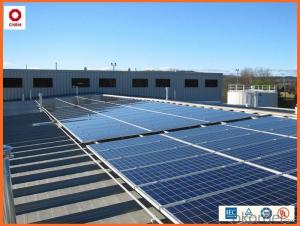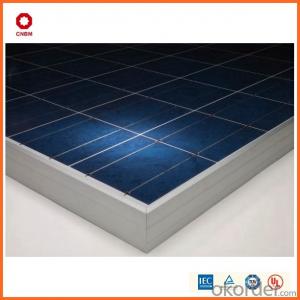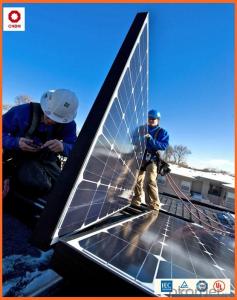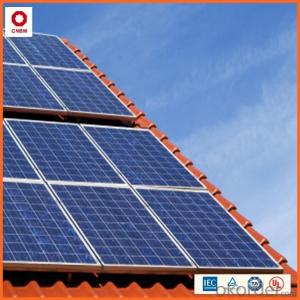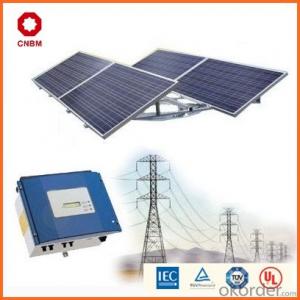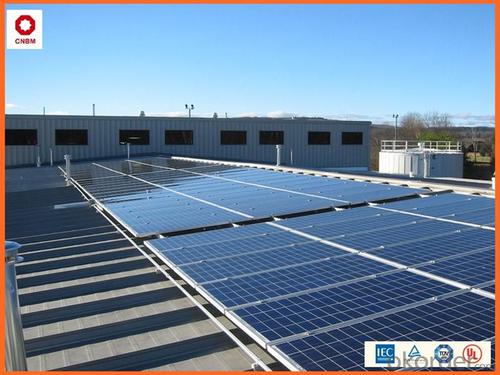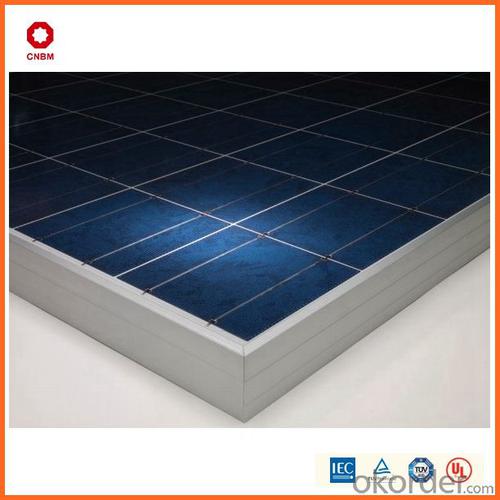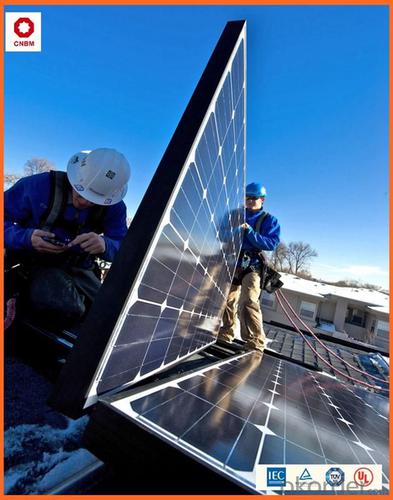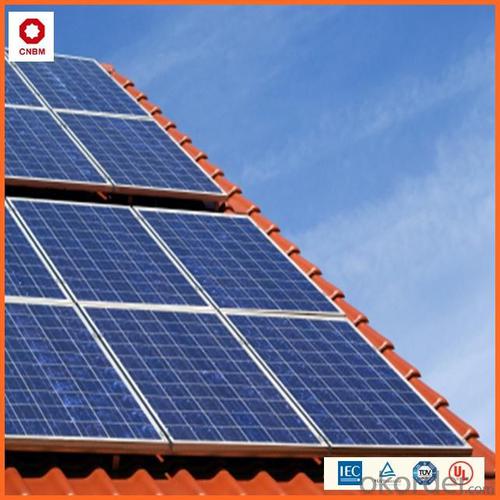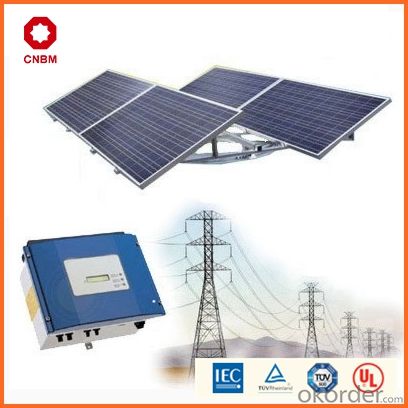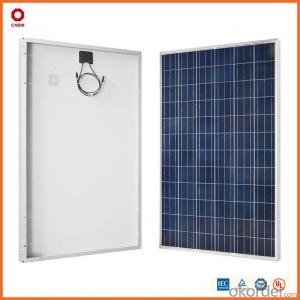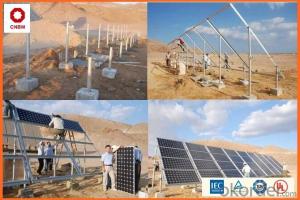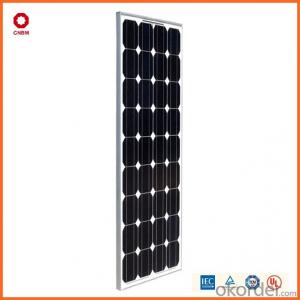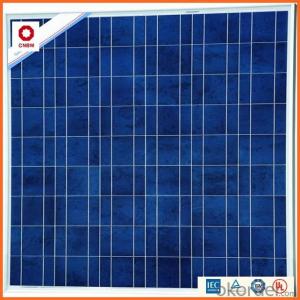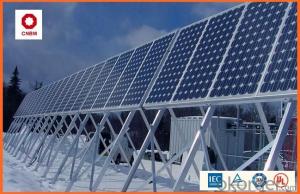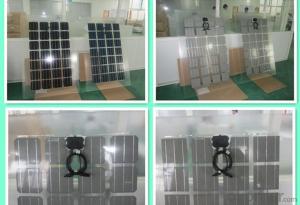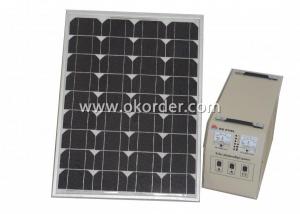Sol Sierra Solar Energy Systems - 55w Small Solar Panels in Stock China Manufacturer
- Loading Port:
- China main port
- Payment Terms:
- TT OR LC
- Min Order Qty:
- 1 watt
- Supply Capability:
- 10000000 watt/month
OKorder Service Pledge
OKorder Financial Service
You Might Also Like
Specification
Product Description:
Hot Sale !!! Quality and Safety of Small Poly Solar Panel 5w~150w
1. Rigorous quality control meets the highest international standards.
2. High-transmissivity low-iron tempered glass, strong aluminium frame.
3. Using UV-resistant silicon.
4. IS09001/14001/CE/TUV/UL
Warranties of Small Poly Solar Panel 35~85w
1. 10 years limited product warranty
2. 15 years at 90% of the minimal rated power output
3. 25 years at 80% of the minimal rated power output
Specification
Characteristics of Poly solar panels CNBM (245-320W) | |||||
Max Power Voltage Vmp(V) | 30.3 | 30.8 | 31.1 | 31.4 | 31.85 |
Max Power Current Imp(A) | 7.60 | 7.64 | 7.73 | 7.81 | 7.85 |
Open Circuit Voltage Voc(V) | 36.1 | 36.6 | 37 | 37.3 | 37.68 |
Short Circuit Current Isc(A) | 8.50 | 8.55 | 8.65 | 8.75 | 8.85 |
Max Power Pm(W) | 230W | 235W | 240W | 245W | 250W |
Temperature Coefficient of Cells Poly solar panels CNBM (245-320W) | |
NOCT | 45± 2 |
Temperature Coeffucients of Isc | 0.0492 |
Temperature Coeffucients of Voc | -0.3374 |
Temperature Coeffucients of Voc | -0.4677 |
Mechanical Data of Poly solar panels CNBM (245-320W) | |
Dimension | 1638 × 982 × 40 mm |
Weight | 19.5 kg |
No. of Cells and Connections | 60 (6 ×10) |
Tolerance | 0 ~ + 5 W |
Cell | Monocrystalline Cell 156 × 156 mm |
Packing | 624 Pcs/40ft(H) Container |
Limits of Poly solar panels CNBM (245-320W) | |
Operating Temperature | -40 to +85 |
Storage Temperature | -40 to +85 |
Max System Voltage | 1000VDC(IEC) / 600VDC(UL) |
Features of our products:
• High conversion efficiency mono/poly-crystalline amorphous silicon solar cells
• Modules incorporate high performance bypass diodes to minimize the power drop caused by shading
• High transmittance, low-iron tempered glass
• High performance EVA encapsulant to prevent destroying and water.
• AI frame: without screw, corner connection. 8 holes on the frame can be installed easily
• Good performance of preventing from atrocious weather such as wind and hails
• Certifications: CE IEC TUV VDE UL, Class I
• 10 years 90% power output warranty
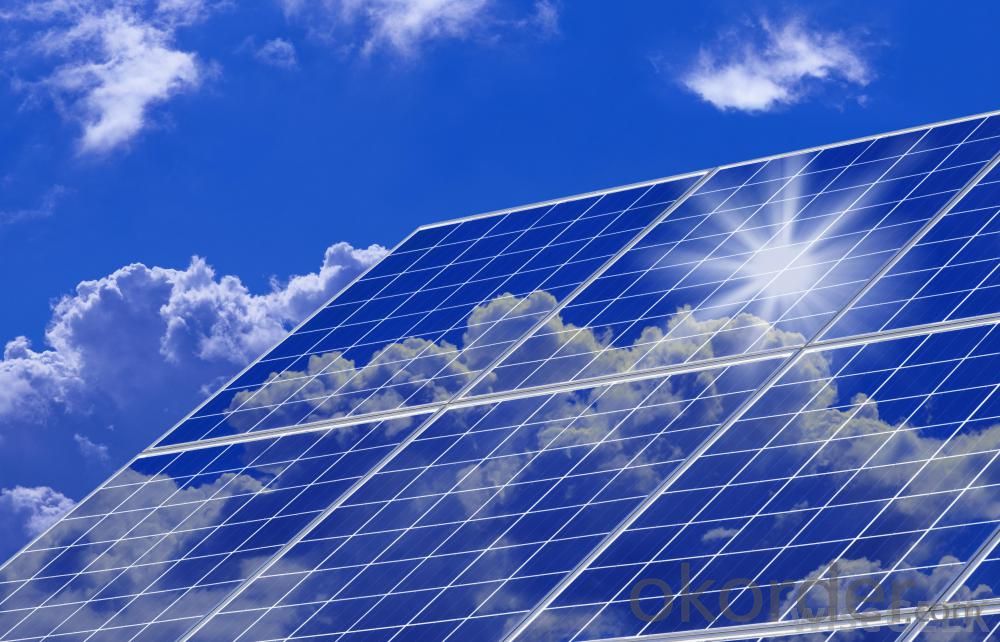
Shipping of Small Poly Solar Panel 35~85w
By Sea | Delivery from Shanghai or Ningbo seaport |
By Air | Departure from Shanghai Pudong Airport |
By Express | Post by DHL, EMS, UPS, TNT. |
Features of our products:
• High conversion efficiency mono/poly-crystalline amorphous silicon solar cells
• Modules incorporate high performance bypass diodes to minimize the power drop caused by shading
• High transmittance, low-iron tempered glass
• High performance EVA encapsulant to prevent destroying and water.
• AI frame: without screw, corner connection. 8 holes on the frame can be installed easily
• Good performance of preventing from atrocious weather such as wind and hails
• Certifications: CE IEC TUV VDE UL, Class I
• 10 years 90% power output warranty
As a professional Solar Panel manufacturer and Supplier in China, we have our customers come around the whole world and our specialization has got a worldwide recognition. Meanwhile, with our superior quality, competitive price, prompt and excellent service, As main role in trade section of CNBM Group, CNBM International Corporation supplies products including Monocrystalline Solar Panel, Polycrystalline Solar Panel ( multicrystalline silicon Solar Panel) have received and enjoyed famous reputation in many countries and regions in the world.
- Q: Are there any disadvantages to using solar energy systems?
- Yes, there are a few disadvantages to using solar energy systems. Firstly, the initial installation cost can be high, making it less accessible for some individuals or communities. Secondly, solar panels require a significant amount of space to generate optimal power, making them less suitable for small or densely populated areas. Additionally, solar energy production is dependent on weather conditions, meaning its output may be variable and less reliable compared to traditional power sources. Lastly, the production and disposal of solar panels can have environmental impacts, especially if not properly managed. However, despite these disadvantages, the long-term benefits of solar energy, such as reduced greenhouse gas emissions and lower energy costs, often outweigh these drawbacks.
- Q: What is the role of power optimizers in a solar energy system?
- The role of power optimizers in a solar energy system is to maximize the energy output of each individual solar panel. They work by individually tracking and optimizing the power output of each panel, which allows for better performance in shaded or unevenly performing panels. Power optimizers also improve system safety by reducing the voltage of the DC power generated by the panels, making the system more efficient and safer to install and operate.
- Q: Can solar energy systems be used for emergency backup power during power outages?
- Yes, solar energy systems can be used for emergency backup power during power outages. Solar panels can generate electricity even when the grid is down, as long as they are connected to a battery storage system. This allows homeowners or businesses to store excess solar energy during the day and use it during an outage. It provides a reliable and sustainable alternative to traditional backup generators, reducing dependence on fossil fuels and ensuring continuous power supply during emergencies.
- Q: How do solar energy systems impact local wildlife?
- Solar energy systems can have both positive and negative impacts on local wildlife. On the positive side, these systems can provide habitat for certain species, such as birds or pollinators, by creating shade and shelter. Additionally, solar panel arrays can be designed to minimize ground disturbance and preserve existing vegetation, benefiting local flora and fauna. However, there are also potential negative effects, such as the risk of bird collisions with solar panels or the displacement of certain species due to changes in habitat. Proper planning, including strategic panel placement and wildlife-friendly landscaping, can help mitigate these impacts and ensure coexistence between solar energy systems and local wildlife.
- Q: Are solar panels weather resistant?
- Yes, solar panels are weather resistant. They are designed to withstand various weather conditions, including rain, snow, hail, and high winds. The materials used in their construction are durable and can handle exposure to the elements for many years. Additionally, solar panels are often installed at an angle to allow for self-cleaning and minimize the accumulation of dirt and debris, further enhancing their weather resistance.
- Q: Can solar energy systems be integrated with battery storage?
- Yes, solar energy systems can be integrated with battery storage. Battery storage allows excess energy generated from solar panels to be stored and used during times when the sun is not shining, such as at night or during cloudy days. This integration helps provide a continuous and reliable source of electricity, reducing reliance on the grid and maximizing the benefits of solar energy.
- Q: How does the efficiency of solar panels vary across different panel technologies?
- The efficiency of solar panels can vary significantly across different panel technologies. Traditional silicon-based panels, also known as monocrystalline or polycrystalline panels, have an average efficiency range of 15% to 20%. However, newer technologies like thin-film solar panels, such as amorphous silicon or cadmium telluride, have lower efficiencies ranging from 10% to 12%. On the other hand, emerging technologies like perovskite solar cells have shown great promise with efficiencies exceeding 25%. Therefore, it can be concluded that the efficiency of solar panels varies based on the specific technology employed.
- Q: Can solar energy systems be used for powering off-grid eco-retreats?
- Yes, solar energy systems can definitely be used for powering off-grid eco-retreats. Solar panels can harness energy from the sun and convert it into electricity, providing a sustainable and renewable source of power. These systems can be installed on the rooftops or in open spaces of eco-retreats to generate electricity for lighting, heating, cooling, and other electrical needs. Additionally, solar energy systems can be combined with batteries to store excess energy for use during nighttime or cloudy days, ensuring a consistent power supply. By utilizing solar energy, off-grid eco-retreats can reduce their dependence on fossil fuels and minimize their environmental impact while enjoying a reliable and clean energy source.
- Q: Can solar panels be installed on facades or windows?
- Yes, solar panels can be installed on facades or windows. There are specially designed solar panels called building-integrated photovoltaics (BIPV) that can be seamlessly integrated into the building's facade or windows, allowing them to generate electricity while also serving as functional architectural elements.
- Q: What is the role of solar concentrators in solar energy systems?
- Solar concentrators play a crucial role in solar energy systems by focusing sunlight onto a smaller area, increasing its intensity and enabling more efficient energy conversion.
Send your message to us
Sol Sierra Solar Energy Systems - 55w Small Solar Panels in Stock China Manufacturer
- Loading Port:
- China main port
- Payment Terms:
- TT OR LC
- Min Order Qty:
- 1 watt
- Supply Capability:
- 10000000 watt/month
OKorder Service Pledge
OKorder Financial Service
Similar products
Hot products
Hot Searches
Related keywords
